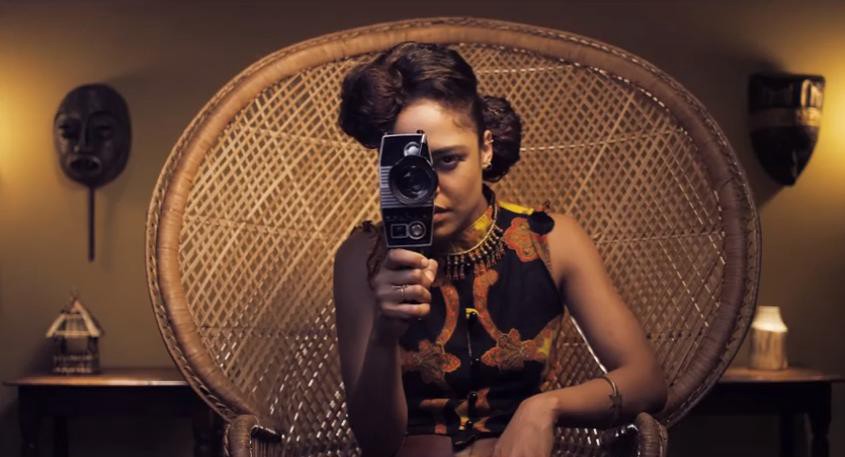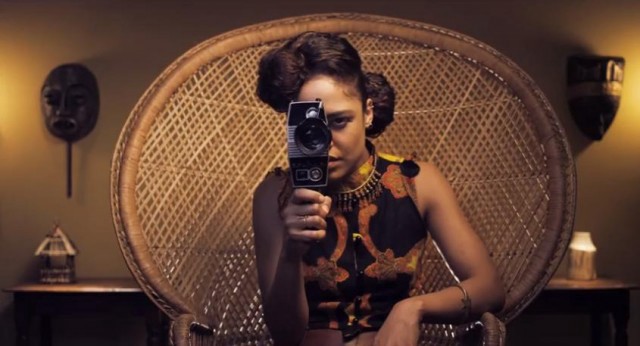Dear White People: What Would You Do?
by Brittany Spanos


I arrived late to Dear White People. Just a few minutes, but it was enough to make a million concerns run rampant through my head as I, the lone, young, half-black girl, entered a room sparsely populated with mostly older and white critics.
Why did I do this?
If anyone asks, I’ll blame the train.
Will they notice?
Am I a stereotype?
The last thought may be the most terrifying: becoming a stock version of yourself based off a single aspect of your identity that doesn’t even begin to define you. Yet the thought lingered and the “colored-people-time” jokes — -about how black people show up late to everything — -remained at the back of my anxiety-ridden head, taunting me. A few scenes into the movie, Samantha White, the protagonist of the film and antagonist of her Ivy League school, joked that “colored people time” didn’t exist when another African-American character, Coco, arrives late to a school assembly. The laugh I released felt cathartic.
Therein lies the spark of new filmmaker Justin Simien’s Dear White People: it’s a film that brutally confronts you with your worst fears, everything you’ve thought too much and too little about, in the sharpest way possible. It’s no violent Bamboozled, the Spike Lee film about black minstrelsy, where these fears, stereotypes, and internal confrontations literally and figuratively destroy everyone who comes into contact with them. In Bamboozled, a black TV producer has spent his life trying to disassociate from any cultural signifiers of his blackness, and when his racist white boss asks him to help make a program more “urban,” the producer makes a modern-day blackface minstrel show to teach his boss a lesson that becomes more successful than anyone imagined.
While Lee’s film is a more surrealistic journey and commentary on modern culture (would anyone actually dare to put people in literal blackface for the sake of comedy anymore?), it, like Simien’s debut, displays the black-versus-white divide as clearly as it does the black-versus-black conflict. Lee’s movie is purposefully over-the-top, delivering a metaphorical message about how stereotypes can destroy us, yet Dear White People somehow remains terrifying while being reassuring in its realism, giving you no answers, but a series of prompts and “What Would You Do?” scenarios. It turns throwaway lines and references from everyday conversations into ways of addressing the culturally embedded assumptions people make based off on the color of a person’s skin. Jokes about hair, food, and music can be overheard everywhere and turned into full sets of dialogue manipulating the tension of the story for either side.
At Winchester University, the setting of the film, each residence hall has its own political system, while also being separated by race, gender, and sexual preference. For these and many college students, there’s comfort in these familiarities, but identity is about more than what we can see, which causes tension to bubble up within the superficially constructed residence halls. When we enter our characters’ lives, the war between the deeply segregated campus is coming to a head given the recent closing of a student resource center available to the black students. Samantha, a contentious, biracial radio host with a show called ‘Dear White People,’ and the rest of the more vigilant students who reside in the all-black residence, are ready to stage a coup against Troy, the current president of their dorm, who happens to be the wealthy son of the school’s dean. When Samantha snatches Troy’s false crown off his head and accidentally wins the election, a more racially-aggressive approach is implemented at Winchester, with the black students marking their territory and allowing no outsiders to enter.
In order to recreate the safe space that the student center had been, the Winchester revolutionaries become determined to keep all those who are not part of their residence hall community away from premises. Stricter entrance into their dorm cafeteria manifests these changes; all outsiders are ousted immediately and without apologies. First to go are the rich and unwittingly racist white frat bros, led by Troy’s girlfriend’s brother who immediately makes a chicken-and-waffles joke. The white bros are followed by Lionel, another black student. Both black and queer, Lionel refuses to abide by labels and has become an outsider due to his unwillingness to let neither his blackness nor queerness define his identity. He struggles to find a suitable living arrangement, having had a history of being ostracized by homophobic black peers and the members of the queer community who fetishize him. With his overgrown afro, uncut since he had no connections to the black students who could assist him with shedding it, and self-deprecating humor, he is treated like an “experiment” by white men who have never been with black guys before and the recipient of the awful and annoying “Can I touch your hair?” question. Lionel becomes the objective eye, not taking a side in the war, but neutrally reporting on it for the school paper. He absorbs all that is occurring around him, but like anyone avoiding the discussion of what we mean when we talk about race in 2014, he is forced to respond and take action.
Like Lionel, every character in Dear White People is well-textured. Issues of wealth, biracialness, and queerness are just the tipping point of a universe that allows complex characters, like Teyonah Parris’ Coco, to be dissected. Coco is the smart and ambitious media “rival” of Samantha; she identifies more with well-behaved Troy than with the more political faction of the dorm. Coco desires assimilation as well as to to blend in and be noticed just like all the other girls, more specifically the white girls, on campus. Unlike Troy, however, Coco finds it more difficult to avoid the microaggressions. So she riles, finding ways of generating controversy. She gives into the stereotypes on purpose, for the attention.
Of course, our instigator Samantha’s internal struggle with her own mixed heritage becomes an allegory for the war between the races at Winchester. Being a mixed person who cannot pass as white, remaining othered by her skin tone, she felt forced to choose sides. Diving into a biracial person’s concerns about what side they are on and whether they’re even allowed on that side is just another way Simien’s film rises above and beyond our ideas of what a film about racial tension at a college can achieve. The internal conflicts, expectations, and realities of being a person born into a world of seemingly opposing identities can be tough to address, but that might be because so many are unwilling to outwardly admit the vast differences we perpetuate between blackness and whiteness.
Being mixed myself, I remember being assigned Nella Larsen’s work in class and finally feeling like someone understood. Larsen detailed the idea of the ‘tragic mulatto,’ a literary device that exaggerates the plight of being mixed as leading to depression or suicide, at a time when being mixed and not passing as white in America could be potentially dangerous. Seeing Samantha’s modern day story unfold was powerful and symbolic of the deep divide within her school; she gives a particularly emotional account of her childhood where walking hand-in-hand with her white father through the halls of her elementary school left her feeling hyperaware of judging eyes. Her comprises between loving and fearing white men raise important questions of what it means when we make one whole side the enemy rather than working to dismantle the ideology and supremacy that keeps that side in power. A stirring debate between Samantha and a white character shed a beautiful light on the ways she could dismantle whiteness without alienating a part of herself — -and the people she loves — -that she shouldn’t have to lose.
Everyone should see this film; it’s simultaneously charming, funny and entertaining, while extremely instructional and informative. Calling it a ‘Race Theory 101’ class in a film simplifies how complex it is, yet the widespread cultural touchstones, from stereotypes of tipping to representation in Tyler Perry movies, make it a relevant learning tool. There’s hope that the film will rile up audience members so much that they’ll leave and immediately look up something like The Birth of a Nation, the racist propaganda film of the early twentieth century that Samantha remakes for her film class. Maybe they’ll go to their nearest library, or at least Google, and search for more information on blackface minstrelsy, the centuries old form of ‘entertainment’ that created some of our most widely known stereotypes of blackness that all still infiltrate and haunt black performance today. This film will immediately touch those who have an awareness of this larger picture, but it is truly meant for those who deny white privilege exists or refuse to understand there is still something wrong with how we talk about race in America. For those skeptics, the film is like a well-supported thesis, squashing every aside and doubt perpetuated by the confrontational title of the film and entire premise.
I left Dear White People feeling as unsettled as every conversation on race has left me feeling the past few years. Like all of those conversations, DWP avoids a solution but instead gives us the most important alleviations to these issues: voices. The inclusion of every voice, from Samantha’s to Troy’s and even the frat bros’, allows for an expectedly uncomfortable climax that was ripped from a thousand headlines. By the end of the film, I forgot I had been a few minutes late. Instead, I was just grateful I had showed up.
Brittany Spanos is a music and culture writer for Rookie, Village Voice, Rolling Stone, and other corners of the web. She will be honest with you about how much Taylor Swift she listens to on a daily basis. Tweet with her.